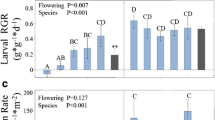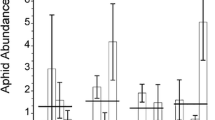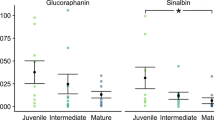Abstract
Studies in crop species show that the effect of plant allelochemicals is not necessarily restricted to herbivores, but can extend to (positive as well as negative) effects on performance at higher trophic levels, including the predators and parasitoids of herbivores. We examined how quantitative variation in allelochemicals (iridoid glycosides) in ribwort plantain, Plantago lanceolata, affects the development of a specialist and a generalist herbivore and their respective specialist and generalist endoparasitoids. Plants were grown from two selection lines that differed ca. 5-fold in the concentration of leaf iridoid glycosides. Development time of the specialist herbivore, Melitaea cinxia, and its solitary endoparasitoid, Hyposoter horticola, proceeded most rapidly when reared on the high iridoid line, whereas pupal mass in M. cinxia and adult mass in H. horticola were unaffected by plant line. Cotesia melitaearum, a gregarious endoparasitoid of M. cinxia, performed equally well on hosts feeding on the two lines of P. lanceolata. In contrast, the pupal mass of the generalist herbivore, Spodoptera exigua, and the emerging adult mass of its solitary endoparasitoid, C. marginiventris, were significantly lower when reared on the high line, whereas development time was unaffected. The results are discussed with regards to (1) differences between specialist and generalist herbivores and their natural enemies to quantitative variation in plant secondary chemistry, and (2) potentially differing selection pressures on plant defense.
Similar content being viewed by others
References
Adler, L. S., Schmitt, J., and Bowers, M. D. 1995. Genetic variation in defensive chemistry in Plantago lanceolata (Plantaginaceae) and its effect on the specialist herbivore Junonia coenia (Nymphalidae). Oecologia 101:75–85.
Barbosa, P., Gross, P., and Kemper, J. 1991. Influence of plant allelochemicals on the tobacco hornworm and its parasitoid, Cotesia congregata. Ecology 72:1567–1575.
Barbosa, P., J. A. Saunders, J. Kemper, R. Trumble, J. Olechno, P. Martinat 1986. Plant allelochemicals and insect parasitoids: Effects of nicotine on Cotesia congregata (Say) (Hymenoptera: Braconidae) and Hyposoter annulipes (Cressen) (Hymenoptera: Ichmonidae). J. Chem. Ecol. 12:1319–1328.
Biere, A., Marak, H. B., and van Damme, J. M. M. 2004. Plant chemical defense against herbivores and pathogens: Generalized defense or trade-offs? Oecologia 140:430–441.
Bottrell, D. G., Barbosa, P., and Gould, F. 1998. Manipulating natural enemies by plant variety selection and modification: A realistic strategy? Annu. Rev. Entomol. 43:347–367.
Bowers, M. D. 1991. Iridoid glycosides, pp. 297–325, in G. A. Rosenthal and M. R. Berenbaum (eds.). Herbivores: Their Interaction with Plant Secondary Metabolites, 2nd edn. Academic Press, Orlando.
Bowers, M. D. 2003. Hostplant suitability and defensive chemistry of the Catalpa sphinx, Ceratomia catalpae. J. Chem. Ecol. 29:2359–2367.
Bowers, M. D. and Collinge, S. K. 1992. Fate of iridoid glycosides in different life stages of the buckeye, Junonia coenia (Lepidoptera, Nymphalidae). J. Chem. Ecol. 18:817–831.
Bowers, M. D. and Puttick, G. M. 1988. Response of generalist and specialist insects to qualitative allelochemical variation. J. Chem. Ecol. 14:319–334.
Bowers, M. D. and Stamp, N. E. 1993. Effects of plant age, genotype, and herbivory on Plantago performance and chemistry. Ecology 74:1778–1791.
Camara, M. D. 1997. Physiological mechanisms underlying the costs of chemical defence in Junonia coenia Hubner (Nymphalidae): A gravimetric and quantitative genetic analysis. Evol. Ecol. 11:451–469.
Campbell, B. C. and Duffey, S. S. 1979. Tomatine and parasitic wasps: Potential incompatibility of plant antibiosis with biological control. Science 205:700–702.
Cortesero, A. M., Stapel, J. O., and Lewis, W. J. 2000. Understanding and manipulating plant attributes to enhance biological control. Biol. Control 17:35–49.
Darrow, K. and Bowers, M. D. 1999. Effects of herbivore damage and nutrient level on induction of iridoid glycosides in Plantago lanceolata. J. Chem. Ecol. 25:1427–1440.
Duffey, S. S., Bloem, K. A., and Campbell, B. C. 1986. Consequences of sequestration of plant natural products in plant–insect–parasitoid interactions, pp. 31–60, in D. J. Boethel and R. D. Eikenbary (eds.). Interactions of Plant Resistance and Parasitoids and Predators of Insects. Horwood, Chichester, UK.
Greenberg, S. M., Sappington, T. W., Legaspi, B. C., Liu, T. X., and Setamou, M. 2001. Feeding and life history of Spodoptera exigua (Lepidoptera: Noctuidae) on different host plants. Ann. Entomol. Soc. Am. 94:566–575.
Gunasena, G. H., Vinson, S. B., and Williams, H. J. 1990. Effects of nicotine on growth, development, and survival of the tobacco budworm (Lepidoptera, Noctuidae) and the parasitoid Campoletis sonorensis (Hymenoptera, Ichneumonidae). J. Econ. Entomol. 83:1777-1782.
Hare, J D. 1992. Effects of plant variation on herbivore–natural enemy interactions., pp. 278–298, in R. S. Fritz and E. L. Simms (eds.). Plant Resistance to Herbivores and Pathogens: Ecology, Evolution and Genetics. University of Chicago press, Chicago, IL.
Hare, J. D. 2002. Plant genetic variation in tritrophic interactions, pp. 8–43, in T. Tscharntke and B. A. Hawkins (eds.). Multitrophic Level Interactions. Cambridge University Press, Cambridge, UK.
Harvey, J. A. and Strand, M. R. 2002. The developmental strategies of endoparasitoid wasps vary with host feeding ecology. Ecology 83:2439–2451.
Harvey, J. A., van Dam, N. M., and Gols, R. 2003. Interactions over four trophic levels: Foodplant quality affects development of a hyperparasitoid as mediated through a herbivore and its primary parasitoid. J. Anim. Ecol. 72:520–531.
Havill, N. P. and Raffa, K. F. 2000. Compound effects of induced plant responses on insect herbivores and parasitoids: Implications for tritrophic interactions. Ecol. Entomol. 25:171-179.
Jensen, S. R. 1991. Plant iridoids, their biosynthesis and distribution in angiosperms, pp. 133–158, in J. B. Harborne and F. A. Tomas-Barberan (eds.). Ecological Chemistry and Biochemistry of Plant Terpenoids. Clarendon Press, Oxford, UK.
Karban, R. and Baldwin, I. T. 1997. Induced Responses to Herbivory. University of Chicago Press, Chicago, IL.
Kuussaari, M., van Nouhuys, S., Hellmann, J. J., and Singer, M. C. 2004. Checkerspot butterfly larval biology, pp. 138–160, in P. R. Ehrlich and I. Hanski (eds.). On the Wings of Checkerspots: A Model System for Population Biology. Oxford University Press, Oxford, UK.
Lei, G. C., Vikberg, V., Nieminen, M., and Kuussaari, M. 1997. The parasitoid complex attacking Finnish populations of the Glanville fritillary Melitaea cinxia (Lep: Nymphalidae), an endangered butterfly. J. Nat. Hist. 31:635–648.
Mallampalli, N., Barbosa, P., and Weinges, K. 1996. Effects of condensed tannins and catalpol on growth and development of Compsilura concinnata (Diptera: Tachinidae) reared in gypsy moth (Lepidoptera: Lymantriidae). J. Entomol. Sci. 31:289–300.
Marak, H. B., Biere, A., and van Damme, J. M. M. 2000. Direct and correlated responses to selection on iridoid glycosides in Plantago lanceolata L. J. Evol. Biol. 13:985-996.
Marak, H. B., A. Biere, and van Damme, J. M. M. 2002a. Systemic, genotype-specific induction of two herbivore-deterrent iridoid glycosides in Plantago lanceolata L. in response to fungal infection by Diaporthe adunca (Rob.) niessel. J. Chem. Ecol. 28:2429–2448.
Marak, H. B., A. Biere, and van Damme, J. M. M. 2002b. Two herbivore-deterrent iridoid glycosides reduce the in-vitro growth of a specialist but not of a generalist pathogenic fungus of Plantago lanceolata L. Chemoecology 12:185–192.
Marak, H. B., A. Biere, and van Damme, J. M. M. 2003. Fitness costs of chemical defense in Plantago lanceolata L: Effects of nutrient and competition stress. Evolution 57:2519–2530.
Nieminen, M., Suomi, J., van Nouhuys, S., Sauri, P., and Riekkola, M. L. 2003. Effect of iridoid glycoside content on oviposition host plant choice and parasitism in a specialist herbivore. J. Chem. Ecol. 29:823–844.
Nishida, R. 2002. Sequestration of defensive substances from plants by Lepidoptera. Annu. Rev. Entomol. 47:57–92.
Novozamsky, I., Houba, V. J. G., van Eck, R., and van Vark, W. 1983. A novel digestion technique for multi-element plant analysis. Comm. Soil Sci. Plant Analysis 14:239–249.
Pereyra, P. C. and Bowers, M. D. 1988. Iridoid glycosides as oviposition stimulants for the buckeye butterfly, Junonia coenia (Nymphalidae). J. Chem. Ecol. 14:917–928.
Price, P. W., Bouton, C. E., Gross, P., McPheron, B. A., Thompson, J. N., and Weis, A. E. 1980. Interactions among three trophic levels: Influence of plants on interactions between insect herbivores and natural enemies. Annu. Rev. Ecol. Syst. 11:41–65.
Puttick, G. M. and Bowers, M. D. 1988. Effect of qualitative and quantitative variation in allelochemicals on a generalist insect—iridoid glycosides and the southern armyworm. J. Chem. Ecol. 14:335–351.
Quicke, P. L. J. 1997. Parasitic Wasps. Chapman & Hall, London.
Rimpler, H. 1991. Sequestration of iridoids by insects, pp. 314–330, in J. B. Harborne and F. A. Tomas-Barberan (eds.). Ecological Chemistry and Biochemistry of Plant Terpenoids. Clarendon Press, Oxford, UK.
Suomi, J., Sirén, H., Wiedmer, S. K., and Riekkola, M. L. 2001. Isolation of aucubin and catalpol from Melitaea cinxia larvae and quantification by micellar electrokinetic capillary chromatography. Anal. Chim. Acta 429:91–99.
Sznajder, B. and Harvey, J. A. 2003. Second and third trophic level effects of differences in plant species reflect dietary specialisation of herbivores and their endoparasitoids. Entomol. Exp. Appl. 109:73–82.
Turlings, T. C. J. and Benrey, B. 1998. Effects of plant metabolites on the behavior and development of parasitic wasps. Ecoscience 5:321–333.
van Nouhuys, S. and Hanski, I. 2004. Natural enemies of checkerspot butterflies, pp. 161–180, in P. R. Ehrlich and I. Hanski (eds.). On the Wings of Checkerspots: A Model System for Population Biology. Oxford University Press, Oxford, UK.
Vickerman, D. B. and Trumble, J. T. 1999. Feeding preferences of Spodoptera exigua in response to form and concentration of selenium. Arch. Insect Biochem. Physiol. 42:64–73.
Wahlberg, N. 2001. The phylogenetics and biochemistry of host-plant specialization in Melitaeine butterflies (Lepidoptera : Nymphalidae). Evolution 55:522–537.
Author information
Authors and Affiliations
Corresponding author
Rights and permissions
About this article
Cite this article
Harvey, J.A., Van Nouhuys, S. & Biere, A. Effects of Quantitative Variation in Allelochemicals in Plantago lanceolata on Development of a Generalist and a Specialist Herbivore and their Endoparasitoids. J Chem Ecol 31, 287–302 (2005). https://doi.org/10.1007/s10886-005-1341-1
Received:
Accepted:
Issue Date:
DOI: https://doi.org/10.1007/s10886-005-1341-1




